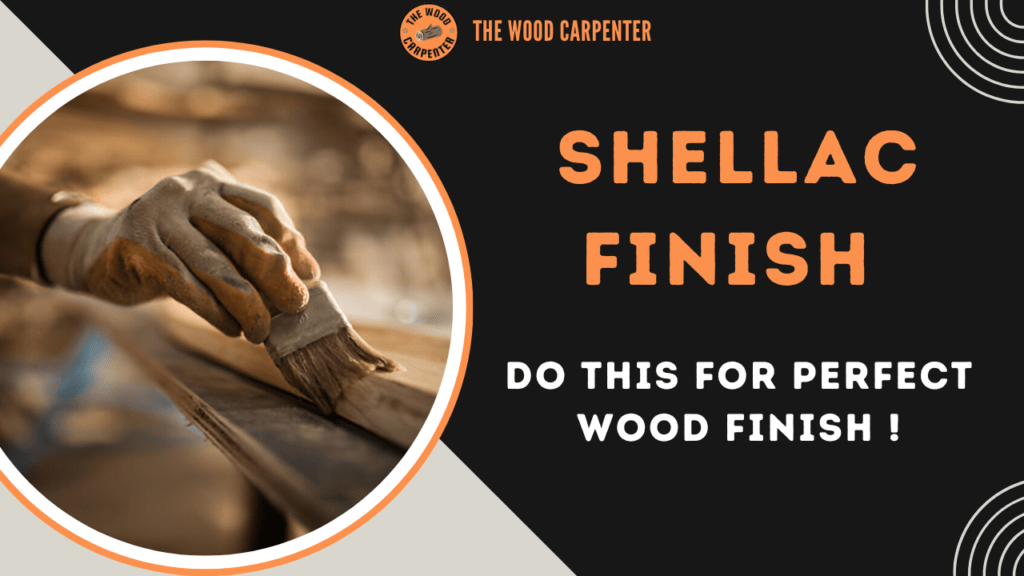
Shellac finish is a traditional and popular way to finish wood. It’s made from natural materials, easy to apply, and gives wood a shiny and smooth look. Whether you are fixing up old furniture or making something new, shellac is a great choice because it looks good, lasts long, and is safe to use.
What Is Shellac ?
Shellac comes from a natural resin made by the female lac bug. These bugs live in the forests of India and Thailand. The resin is collected and processed to make a wood finish. When mixed with alcohol, shellac turns into a liquid. This liquid can be brushed onto wood. As the alcohol dries, the shellac hardens and forms a strong, glossy layer on the wood.
Shellac comes in a few forms: flakes (which you mix with alcohol yourself), liquid shellac, and pre-mixed shellac. Each one works a little differently, but they are all used in similar ways.
Why Use Shellac ?
One big reason to use shellac is that it dries much faster than most other finishes. It also gives a bright, shiny surface that feels smooth and clear. If the finish gets damaged, you can easily fix it, which makes shellac perfect for both new and old wooden items.
A Brief History of Shellac
Shellac has been used for a very long time—thousands of years! The ancient Egyptians used it to protect and decorate their wooden furniture and other items. In the 1800s, it became very popular in Europe and America. People used it on furniture, musical instruments, and artwork. Even today, many woodworkers still love using shellac because of its beautiful finish and flexibility.
Advantages of Using Shellac Finish
Natural and Safe: Shellac is a natural product, making it non-toxic and safe for use in homes, especially around children and pets.
Quick Drying: Shellac dries quickly, often within 30 minutes to an hour. This makes it ideal for projects that require a fast turnaround.
Excellent Clarity and Gloss: Shellac imparts a clear, high-gloss finish that enhances the natural beauty of the wood grain.
Easy to Repair and Refinish: One of the standout features of shellac is how easy it is to repair. Unlike other finishes, shellac can be simply re-applied without the need for sanding or stripping.
How to Apply Shellac Finish
Preparing the Wood Surface: The wood should be sanded smoothly and cleaned of dust and debris before application. This ensures that the shellac adheres properly and creates a flawless finish.
Choosing the Right Tools: You’ll need a brush, cloth, or spray gun to apply shellac. The type of tool you choose will depend on the size of your project and the finish you want.
Step-by-Step Application Process:
- Stir the shellac to avoid settling.
- Apply a thin, even coat using long strokes.
- Allow the first coat to dry completely before applying the next.
- Sand lightly between coats for a smoother finish.
Tips for a Smooth Finish: Apply multiple thin coats rather than one thick coat. This helps avoid streaking and uneven drying.
Also read:
Wood Finishes 101: Make the Right Choice for your project !
Osmo Polyx Oil: How to Apply in 10 Simple Steps
Is Danish Oil Food Safe? Everything You Need to Know
Shellac vs. Other Wood Finishes
| Finish Type | Durability | Drying Time | Toxicity | Eco-Friendliness | Ease of Repair |
| Shellac | Moderate | Very Fast | Low | High | Very Easy |
| Polyurethane | High | Slow | Moderate | Low | Difficult |
| Lacquer | High | Fast | Moderate | Low | Moderate |
| Wax | Low | Fast | Low | High | Easy |
Common Mistakes to Avoid When Using Shellac
Using the Brush Too Much: Shellac dries very fast. If you brush over the same area too many times, it can leave streaks or bubbles on the surface.
Applying Too Much at Once: If you put on a thick layer of shellac, it may not dry properly. This can cause peeling or cracks. It’s better to apply several thin coats.
Not Enough Fresh Air: Shellac contains alcohol, which gives off strong fumes. Always use it in a room with good airflow or near an open window to stay safe.
How to Take Care of Shellac-Coated Surfaces
Shellac surfaces are easy to care for. Just dust them regularly and clean them gently with a soft cloth. If the surface gets a small scratch or chip, you don’t need to remove all the shellac. You can simply add a little more to that spot to make it look new again.
Best Wood Projects for Shellac Finish
Shellac is perfect for many kinds of wood projects. It looks great on furniture, musical instruments, and decorative items. If you want a shiny, smooth finish that brings out the natural beauty of the wood, shellac is a great choice.
It’s especially good for detailed wood carvings and polished tabletops where you want the wood grain to really shine.
Pros and Cons of Shellac Finish
Benefits: Non-toxic, natural, quick drying, easy to repair, and great for showcasing wood grain.
Drawbacks: Not as durable as some other finishes, susceptible to water damage, and may not be the best for outdoor use.
Shellac and Environmental Considerations
Shellac is a sustainable choice for wood finishing. As a natural resin, it doesn’t contribute to environmental harm, making it an eco-friendly option. It’s also non-toxic and safe for home use.
Where to Buy Shellac
Shellac can be found at most hardware stores or online retailers. Prices vary depending on the form (flakes, liquid, pre-mixed) and the quality of the product. On average, expect to pay between $10 to $30 for a pint of shellac.
Final Thoughts
Shellac finish is a fantastic option for many woodworking projects. Its beautiful, glossy finish and natural origins make it a great choice for both professionals and DIY enthusiasts. Whether you’re restoring furniture or creating a new piece, shellac will provide a classic, durable finish that stands the test of time.
FAQs about Shellac Finish for Wood
1. How long does a shellac finish last?
A shellac finish can last several years with proper care and maintenance.
2. Can shellac be used on outdoor furniture?
Shellac is not recommended for outdoor use as it is susceptible to water damage.
3. Can I apply shellac over other finishes?
Yes, shellac can be applied over other finishes, provided the surface is properly prepared.
4. Is shellac finish water-resistant?
Shellac is not highly water-resistant, so it’s best used in dry, indoor environments.
5. How do I fix a mistake when applying shellac?
If you make a mistake, simply sand the area lightly and reapply shellac for a smooth, flawless finish.

